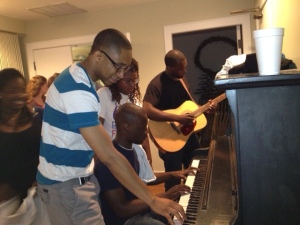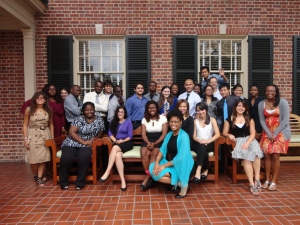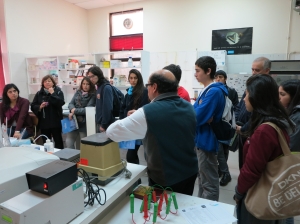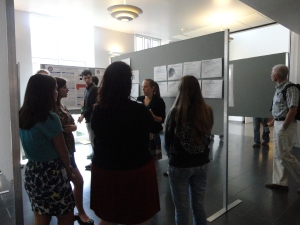 Davide Mercadante explains the featured cover of the July 18 issue of Biophysical Journal. He is a fourth-year student at Massey University in Auckland, New Zealand, from Naples, Italy. Mercandante has recently submitted his PhD dissertation and has begun looking for a post-doctoral position. The cover image is from the article Bovine β-Lactoglobulin Is Dimeric under Imitative Physiological Conditions: Dissociation Equilibrium and Rate Constants over the pH Range 2.5 to 7.5, by authors Davide Mercadante, Laurence D. Melton, Gillian E. Norris, Trevor S. Loo, Martin A.K. Williams, Renwick C.J. Dobson and Geoffrey B. Jameson.
Davide Mercadante explains the featured cover of the July 18 issue of Biophysical Journal. He is a fourth-year student at Massey University in Auckland, New Zealand, from Naples, Italy. Mercandante has recently submitted his PhD dissertation and has begun looking for a post-doctoral position. The cover image is from the article Bovine β-Lactoglobulin Is Dimeric under Imitative Physiological Conditions: Dissociation Equilibrium and Rate Constants over the pH Range 2.5 to 7.5, by authors Davide Mercadante, Laurence D. Melton, Gillian E. Norris, Trevor S. Loo, Martin A.K. Williams, Renwick C.J. Dobson and Geoffrey B. Jameson.
The image was composed in two phases. First, the electrostatic potentials for bovine beta-lactoglobulin A were calculated and visualized by coloring the protein surface by the electrostatic potential and representing the electric field using field lines. Considering that the research has been carried out through a combined experimental and theoretical approach, we wanted to make sure that not just the computational part of our study was represented in the image. Therefore, on the white background we decided to insert samples of sedimentation velocity and sedimentation equilibrium curves, fitted in order to reveal the oligomerization behavior of beta-lactoglobulin A. The collage of the different bits, experimental and computational, gave us the results we wanted.
Essentially, the nature of our results prompted us to create and submit a cover art image. The investigation of the electrostatic properties of macromolecules has a strong visual component that is very often conducive to art work. Science is as much about images as it is about numbers.
The image does not only reflect our scientific research. IT IS our scientific research. The image is not separated from the research, and can be considered as our best attempt to visualize and transmit the significance of our investigation. You could crop the different parts of the image, insert them into a paper, and they would make perfect sense.
Electrostatic properties of macromolecules are, almost by definition, very difficult to treat computationally. However, the calculations performed in order to elucidate such properties have an enormous communicative power as they combine many strategies used by artists to describe and communicate the world around them. For example, a wide range of colors is employed in combination to the visualization of macromolecular structures. The analytical ultracentrifugation data, where colors represent time, show the collective macroscopic behavior of macromolecules in ultra-strong gravitational fields, behavior determined by the microenvironment of the individual molecules. Connecting the microscopic to the macroscopic, and vice versa, has a very strong artistic potential.
The feeling of having our image chosen for the cover can be simply expressed in two words: successful and rewarded. We feel successful because the final aim of any scientist is, on one side, the satisfaction of our curiosity about the world, and on the other, the transmission of such curiosity to other people through the published article. The cover image of a book or a journal conveys information but also plays to the emotions of the potential buyer and reader. Having this image selected for the cover of Biophysical Journal provides recognition that our research will encourage more people to read the contents of Biophys J, which has a top role in diffusing molecular biophysics across the scientific community. The publication of our research on the cover is a reward to the passion we invest to conduct our research every day and to transmit its significance among other scientists.
Sometimes scientists and artists are the same thing. This was more commonly accepted and represented in the ancient cultures (mostly during the Renaissance). In many cases, the scientist was also an inventor, a sculptor or a painter. Nowadays the two figures are well separated – probably because science is often considered as too “brainy” to be art. However, science and art are probably not too far apart in reality. Art is the representation of concepts that strongly recall emotions and has a small rational component. Science, on the other hand, has a bigger rational component but I, as a scientist, feel exactly like an artist when conducting research. The quantity and quality of the emotions felt are exactly the same kind and have the same power.
We already have an idea for our next science-as-art submission. At the moment, we are preparing an article on the molecular dynamics of enzyme-substrate interactions of a key enzyme from a bacterial pathogen that attacks the polysaccharide cell walls of plants. In this case, the combination of natural elements and molecular structures and conformations can have a strong communicative and visual effect. It’s all about combining knowledge and feelings.
Readers can view additional research by the Massey University team behind this article using the following links:
Laurie Melton: http://web.chemistry.auckland.ac.nz/staff-profile-jahia.aspx?staffid=18
Bill Williams: http://ifs.massey.ac.nz/people/staff.php?personID=66
Geoff Jameson: http://ifs.massey.ac.nz/people/staff.php?personID=22






